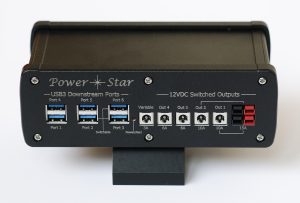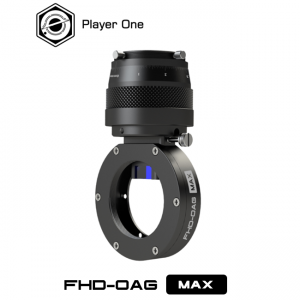The Power*Star power hub is a power and data distribution hub for astrophotography from Wa-chur-ed Observatory. The primary motivation in designing the Power*Star was to minimize the amount of cabling required in astrophotography, especially cables going between the fixed and moving parts of a mount.
 The Power*Star power hub is typically mounted at the telescope and requires just 2 cables to the fixed base; a 12VDC power cable (included with Power*Star), and a USB cable, ideally USB3. The power is distributed in several different forms and a different types of connectors. The USB cable connects to a full-featured USB3 hub with 6 downstream ports.
The Power*Star power hub is typically mounted at the telescope and requires just 2 cables to the fixed base; a 12VDC power cable (included with Power*Star), and a USB cable, ideally USB3. The power is distributed in several different forms and a different types of connectors. The USB cable connects to a full-featured USB3 hub with 6 downstream ports.
As Greg Marshall owner of Wa-chur-ed Observatory notes, “In addition to power and data, there are two other services typically needed at the telescope; focus control and dew heater control. Since everything needed for these services is already present in Power*Star, the connectors and software were added to make them available.”
The standard configuration includes a universal saddle to allow easy mounting to either a Vixen or Losmandy style dovetail. Mounting without the saddle requires 2 M5 bolts spaced 35mm apart or a custom adapter.
 The Power*Star power hub includes standalone application software (for Windows) plus ASCOM drivers for focus control, observing conditions (temperature, humidity, and dew point), and ‘switches’. INDI drivers are (or soon will be) available from 3rd parties, but Wa-chur-ed Observatory cannot provide technical support for these drivers.
The Power*Star power hub includes standalone application software (for Windows) plus ASCOM drivers for focus control, observing conditions (temperature, humidity, and dew point), and ‘switches’. INDI drivers are (or soon will be) available from 3rd parties, but Wa-chur-ed Observatory cannot provide technical support for these drivers.
The top-level specifications for the Power*Star power hub include:
– 30-amp peak current capacity (a maximum of 20A continuous is recommended, but most users will need less than 10A).
– Power input is via Anderson PowerPole connector.
– 4 power output channels: 2 channels with parallel PowerPole and 2.1mm barrel connectors (max 15A and 10A, respectively) and 2 channels with 2.1mm barrel connectors (max 6A).
– 1 variable voltage output, providing 3 to 10V (regulated) at up to 3A, adjustable in 0.1V increments.
– 2 dedicated dew heater channels (RCA jacks, 5A max).
– 1 Multi-Purpose output, configurable as 1 of 3 functions (max 6A in each case): Standard 12V output; 12V PWM output (typically used to control brightness of a flat calibration panel or speed of a fan); and 3rd dew heater channel.
– 6 USB3.1 Gen 1 (superspeed) downstream USB ports: 3 USB ports have USB3 standard power capability; 0.9A plus always on and 3 USB ports are capable of up to 2A each and can be switched on/off under software control.
– Focus control for both unipolar and bipolar stepper motors
– Environment sensor provides temperature, humidity, and dew point
– Numerous power protection features: Reverse polarity protection; Over- and under-voltage protection; Over-current protection for both total current and per-port current (including short-circuit protection); Internal voltage monitor (turns off outputs if a system failure is detected); Motor faults (excessive motor current); and User defined limits for most current and voltage faults.
– Power monitoring features: Input voltage; Total current (includes USB devices and internal usage); Cumulative amp-hour usage (useful for battery life estimation); and Per-port current (except the variable voltage output, which instead provides a voltage measurement).
– Data graphing and export shows input voltage, total current, temperature, humidity, and dew point over time
– Dew heaters can be configured to operate automatically, based on the environment sensor data
You can learn more about the Power*Star power hub here.
 And to make it easier for you to get the most extensive news, articles and reviews that are only available in the magazine pages of Astronomy Technology Today, we are offering a 1 year magazine subscription for only $6! Or, for an even better deal, we are offering 2 years for only $9. Click here to get these deals which only will be available for a very limited time. You can also check out a free sample issue here.
And to make it easier for you to get the most extensive news, articles and reviews that are only available in the magazine pages of Astronomy Technology Today, we are offering a 1 year magazine subscription for only $6! Or, for an even better deal, we are offering 2 years for only $9. Click here to get these deals which only will be available for a very limited time. You can also check out a free sample issue here.



